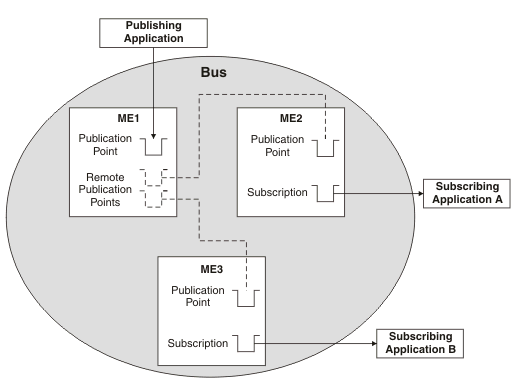Network Deployment (Distributed operating systems), v8.0 > Applications > Service integration > Bus destinations > Message points > Remote message points
Publish/subscribe messaging example by using remote publication points
When a publishing or subscribing application is remote from its destination, remote publication points are used to manage the flow of messages between the messaging engine where the destination is located, and the messaging engine the application is attached.
The following diagram illustrates the use of remote publication points in publish/subscribe messaging. Messages are published to a publication point on ME1, and are routed to publication points on ME2 and ME3 through remote publication points on ME1. The messages are consumed from subscriptions on ME2 and ME3.
Figure 1. Publish/subscribe messaging by using remote publication points

The sequence of steps involved in remote publish/subscribe messaging is as follows:
- The administrator creates a topic space destination on the bus; this creates a publication point on each messaging engine in the bus.
- The subscribing applications register subscriptions for a topic on the topic space on their local messaging engines. ME1 is informed that ME2 and ME3 are interested in the topic.
- The publishing application, on ME1, publishes a message for topic and topic space to the bus, for distribution to the publication points on each messaging engine.
- The remote publication points on ME1 queue the message for transmission to their respective publication points on ME2 and ME3.
- The message is sent to the publication points on ME2 and ME3 as soon as possible. ME1 remembers the existence of the message until both ME2 and ME3 confirm that they have received the message.
- The subscribing applications consume the message through their subscriptions on ME2 and ME3.
In figure one, the subscribing applications are attached to the same messaging engines that their subscriptions were created on. If a subscribing application has a durable subscription, it is possible for the application to be attached to a different messaging engine than the messaging engine that the subscription was created on. In this case the subscribing application accesses its subscription through a remote subscription on the messaging engine the application is attached. In figure two, messages are published to ME1, and are routed to the durable subscripton that is on ME2. The messages are consumed from ME2 through a remote subscription on ME3.
Figure 2. Publish/subscribe messaging using a remote subscription
 In this situation, Subscribing Application B consumes messages from its subscription in the same way as an application consumes remotely from a queue point, as detailed in Point-to-point messaging example by using remote queue points.
In this situation, Subscribing Application B consumes messages from its subscription in the same way as an application consumes remotely from a queue point, as detailed in Point-to-point messaging example by using remote queue points.
Point-to-point messaging example by using remote queue points
Use durable subscriptions
Known remote publication points [Collection]
Known remote publication points [Settings]
Remote Publication Points [Collection]
Remote Publication Points [Settings]
Topics [Collection]
 Concept topic
Concept topic